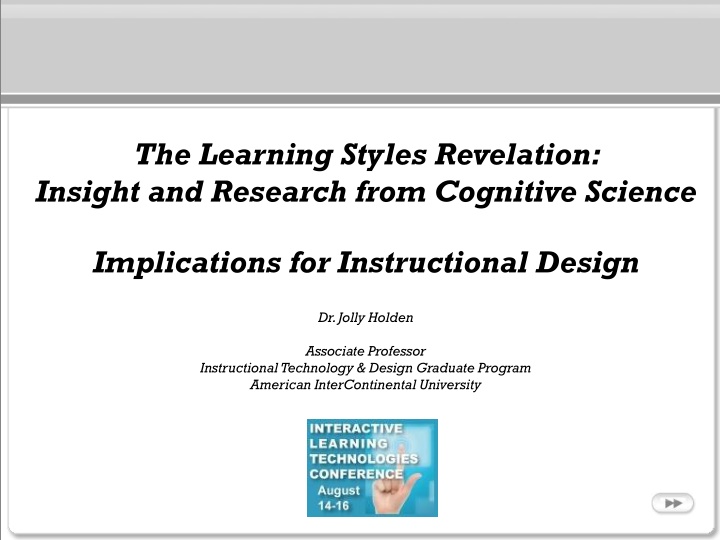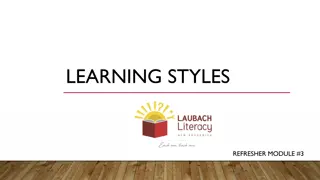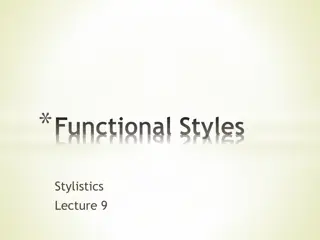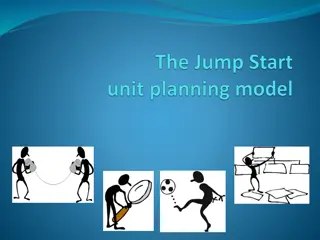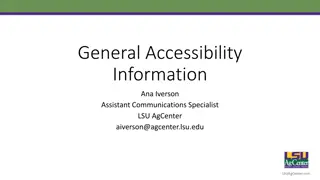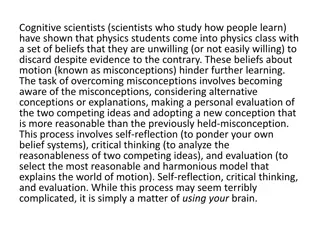Learning Styles and Instructional Design: Debunking Misconceptions
The concept of learning styles as predictors of learning outcomes is widely misunderstood. Research shows little impact on learning outcomes. This presentation explores the implications for instructional design and questions the relevance of considering learning styles as a variable in instructional design.
Download Presentation

Please find below an Image/Link to download the presentation.
The content on the website is provided AS IS for your information and personal use only. It may not be sold, licensed, or shared on other websites without obtaining consent from the author.If you encounter any issues during the download, it is possible that the publisher has removed the file from their server.
You are allowed to download the files provided on this website for personal or commercial use, subject to the condition that they are used lawfully. All files are the property of their respective owners.
The content on the website is provided AS IS for your information and personal use only. It may not be sold, licensed, or shared on other websites without obtaining consent from the author.
E N D
Presentation Transcript
The Learning Styles Revelation: Insight and Research from Cognitive Science Implications for Instructional Design Dr. Jolly Holden Associate Professor Instructional Technology & Design Graduate Program American InterContinental University C:\Users\User\Desktop\Documents\AIU Online\Lectora Folder\Learning Activity Development 2.7\images\0502_next.jpg
Why Are You Here? (besides the free doughnuts) Opinion: The concept of learning styles in predicting learning outcomes is a commonly misunderstood and misapplied instructional strategy when designing content. Fact: Research has revealed that learning styles have little, if any, affect on predictinglearning outcomes. Result:While the perception is people learn better when information is presented in their preferred learning style, current evidence has not confirmed this. C:\Users\User\Desktop\Documents\AIU Online\Lectora Folder\Learning Activity Development 2.7\images\0502_back.jpg C:\Users\User\Desktop\Documents\AIU Online\Lectora Folder\Learning Activity Development 2.7\images\0502_next.jpg
So What: Presentation Objectives Question: Since the primary goal of instruction is to attain the desired learning outcomes, should learning styles be considered a variable when designing instruction? Objectives: Review the current research on learning styles Review the cognitive information processing model Examine the implications when designing instruction C:\Users\User\Desktop\Documents\AIU Online\Lectora Folder\Learning Activity Development 2.7\images\0502_back.jpg C:\Users\User\Desktop\Documents\AIU Online\Lectora Folder\Learning Activity Development 2.7\images\0502_next.jpg
Presentation Menu (Click any of the hyperlinks to go directly to that topic) Learning Styles The Debate The Learning Style Hypothesis Review of the Research What are Learning Modalities? The Science Behind Learning Cognitive Information Processing Model Cognitive Learning Strategies Design Techniques Multimedia Design Techniques & Principles Addendum What Do the Experts Say? Learning Style Resources Prior Return slide to Menu Next slide C:\Users\User\Desktop\Documents\AIU Online\Lectora Folder\Learning Activity Development 2.7\images\0502_back.jpg C:\Users\User\Desktop\Documents\AIU Online\Lectora Folder\Learning Activity Development 2.7\images\0502_home.jpg C:\Users\User\Desktop\Documents\AIU Online\Lectora Folder\Learning Activity Development 2.7\images\0502_next.jpg
Do You Know Your Learning Style(s)? Are you a Converger; diverger; assimilator; accommodator (Kolb s LSI) Concrete sequential; abstract random; abstract sequential; concrete random (Gregorc s learning style topography) Leveling/Sharpening cognitive styles (Klein) Impulsive/Reflective cognitive styles (Kagan) Visual/Haptic (Lowenfeld & Brittain) Sensory/intuitive; visual/verbal; active/reflective; sequential/global (Felder & Silverman four-dimension model) Grasha-Reichmann Student Learning Style Scales Activists; reflectors; pragmatists; theorists (Honey & Mumford's learning styles) Analytic/non-analytic; conceptualizing (Messick) Canfield Learning Styles Inventory Verbalizer-Visualizer learning styles Field dependent/field independent (Witkin s cognitive styles) Visual, aural, kinesthetic (Dunn & Dunn VAK learning styles) Note: The literature has identified over 70 different learning styles! C:\Users\User\Desktop\Documents\AIU Online\Lectora Folder\Learning Activity Development 2.7\images\0502_back.jpg C:\Users\User\Desktop\Documents\AIU Online\Lectora Folder\Learning Activity Development 2.7\images\0502_home.jpg C:\Users\User\Desktop\Documents\AIU Online\Lectora Folder\Learning Activity Development 2.7\images\0502_next.jpg
Insight [and research] into Learning Styles A recent study published in the Psychological Science in the Public Interest challenged the prevailing concept of learning styles and their affect on student performance. The investigators (four prominent cognitive psychologists) found no evidence for validating the educational applications of learning styles into general educational practice. A 2010 article from the Australian Journal of Educational Research stated research conducted over the last 40 years has failed to show that individual attributes can be used to guide effective teaching practice. According to a 2013 study, learning styles are considered an educational legend in that that all learners are aware of their own personal learning style and that good instruction requires diagnosing the learning style of each individual and aligning instruction accordingly (Kirschner & van Merrinboer, 2013) . Learning styles theorists assume people learn by adding information to memory, as if the mind were an empty vessel that needs to be filled with information (Clark & Mayer, E- learning and the Science of Instruction, 3rd Ed., 2011). C:\Users\User\Desktop\Documents\AIU Online\Lectora Folder\Learning Activity Development 2.7\images\0502_back.jpg C:\Users\User\Desktop\Documents\AIU Online\Lectora Folder\Learning Activity Development 2.7\images\0502_home.jpg C:\Users\User\Desktop\Documents\AIU Online\Lectora Folder\Learning Activity Development 2.7\images\0502_next.jpg
The Essence of the Debate This is not a new debate but a continuing investigation into the efficacy of learning styles that has spanned 60 years. To that end, there is a strong intuitive appeal to the notion there are individual preferences and styles of learning. Cognitive psychologists have discovered that recent research by neuroscience in how the brain stores and retrieves information supports their statement concerning the accuracy of learning styles as a predictor of performance. learning styles theory appeals to the underlying culture's model of the person ensures the theory's continued survival, despite the evidence against its utility. Rather than being a harmless fad, learning styles theory perpetuates the very stereotyping and harmful teaching practices it is said to combat. Australian Journal of Education, Vol. 54, No. I, 2010, 5-17 C:\Users\User\Desktop\Documents\AIU Online\Lectora Folder\Learning Activity Development 2.7\images\0502_back.jpg C:\Users\User\Desktop\Documents\AIU Online\Lectora Folder\Learning Activity Development 2.7\images\0502_home.jpg C:\Users\User\Desktop\Documents\AIU Online\Lectora Folder\Learning Activity Development 2.7\images\0502_next.jpg
The Essence of the Debate [and the disagreement] Claims for adapting instruction to learning styles assume they are stable, replicable interactions between measures of learning styles and instructional methods. Not supported by available research evidence that visualizers learn better with visual forms of instruction and verbalizers learn better with verbal modes of instruction. A number of reviews of ATI (aptitude treatment interactions) research have found similar conclusions about the types of interactions and instructional methods. verbalizer-visualizer measures failed to produce significant attribute treatment interactions (ATIs). There was not strong support for the hypothesis that verbal learners and visual learners should be given different kinds of multimedia instruction . Massa, L.J., & Mayer, R., 2006. Testing the ATI hypothesis: Should multimedia instruction accommodate verbalizer-visualizer cognitive style? Science Direct C:\Users\User\Desktop\Documents\AIU Online\Lectora Folder\Learning Activity Development 2.7\images\0502_back.jpg C:\Users\User\Desktop\Documents\AIU Online\Lectora Folder\Learning Activity Development 2.7\images\0502_home.jpg C:\Users\User\Desktop\Documents\AIU Online\Lectora Folder\Learning Activity Development 2.7\images\0502_next.jpg
Predicting Learning Styles: The Basis of the Theory [and the confusion] The genesis of the [VAK] theory of learning styles is that if you can design instruction that matches a student s style , they should learn better. The assumption is once you identify a specific style, you can design instruction that best fits the style. The visual learner will understand best when information (content) is presented to the visually. The auditory learner will understand best when information is described to them orally. The kinesthetic learner will understand best when they can touch/feel what is being presented to them. These are statements of predictability, per se, you are predicting learning outcomes based upon learning styles C:\Users\User\Desktop\Documents\AIU Online\Lectora Folder\Learning Activity Development 2.7\images\0502_back.jpg C:\Users\User\Desktop\Documents\AIU Online\Lectora Folder\Learning Activity Development 2.7\images\0502_home.jpg C:\Users\User\Desktop\Documents\AIU Online\Lectora Folder\Learning Activity Development 2.7\images\0502_next.jpg
What Does the Research Reveal About Learning Styles? Simply stated, the research has not revealed a compelling argument as to the impact of learning styles and their effect on predictinglearning outcomes. Research does not support designing instruction to match learning styles. After more than 30 years of research, no consensus has been reached about the most effective instrument for measuring learning styles and there is no agreement about the most appropriate pedagogical interventions. Click here for the Google Effect The findings of this [VAK] research adds to the existing body of discourse and consolidates the belief that learning styles as determined by self-assessment instruments do not necessarily improve performances . Effectiveness of Personalized Learning Paths on Students Learning Experiences in an e-Learning Environment, European Journal of Open, Distance and E-Learning (2013) C:\Users\User\Desktop\Documents\AIU Online\Lectora Folder\Learning Activity Development 2.7\images\0502_back.jpg C:\Users\User\Desktop\Documents\AIU Online\Lectora Folder\Learning Activity Development 2.7\images\0502_home.jpg C:\Users\User\Desktop\Documents\AIU Online\Lectora Folder\Learning Activity Development 2.7\images\0502_next.jpg
What Does the Research Reveal About Learning Styles? Postulates learning/cognitive styles have <5% effect on the variability in learning. The majority of research does not support a significant statistical relationship between learning/cognitive styles and learning outcomes. Small sample sizes, flawed sampling methodology, and non- experimental research designs casts doubt on the results of VAK learning style research. Based on several decades of empirical evidence, matching learning activities/ strategies with specific learning styles does not often result in improved learning. Howles & Jeong 2009. Learning Styles and the Design of E-learning: What the Research Says. C:\Users\User\Desktop\Documents\AIU Online\Lectora Folder\Learning Activity Development 2.7\images\0502_back.jpg C:\Users\User\Desktop\Documents\AIU Online\Lectora Folder\Learning Activity Development 2.7\images\0502_home.jpg C:\Users\User\Desktop\Documents\AIU Online\Lectora Folder\Learning Activity Development 2.7\images\0502_next.jpg
What Does the Research Reveal About Learning Styles? Low validity and reliability scores of the VAK instruments used to identify specific learning styles raise serious doubts about their psychometric properties. In other words, if the tests used to identify learning styles are not reliable or valid, then any conclusions or results based upon them are suspect. Intervening variables confound the results (click here for factors that affect the variability in learning). Assessment of learning styles based on sensory modality has no correlation with learning and memory. Since self-report measures are used to determine learning styles, the adequacy of such self-reports for the assessment of learning styles is questionable (Kirschner & van Merrinboer, 2013) Research reveals that most learning style instruments have such serious weaknesses (e.g. low reliability & poor validity) it is recommend their use in research and practice should be dis- continued. Investigations of the properties of a variety of scales have revealed that even the most widely used are inadequate in this regard. Australian Journal of Education, Vol. 54, No. I, 2010, 5-17 C:\Users\User\Desktop\Documents\AIU Online\Lectora Folder\Learning Activity Development 2.7\images\0502_back.jpg C:\Users\User\Desktop\Documents\AIU Online\Lectora Folder\Learning Activity Development 2.7\images\0502_home.jpg C:\Users\User\Desktop\Documents\AIU Online\Lectora Folder\Learning Activity Development 2.7\images\0502_next.jpg
What are Learning Modalities? Learning, or perceptual modalities, are sensory based and refer to the primary way our bodies take in information though our senses: visual (seeing), auditory (hearing), kinesthetic (moving), and tactile (touching). Humans are multi-sensory in that the brain performs several activities at once when processing information (e.g., tasting and smelling, hearing and seeing), but are processed through different channels in our brain. Separate structures in the brain are highly interconnected and there is profound cross- modal activation and transfer of information between sensory modalities . Thus, it is incorrect to assume that only one sensory modality is involved with information processing. Neuromyths in education: Prevalence and predictors of misconceptions among teachers, frontiers in Educational Psychology, 2012: http://www.frontiersin.org/Educational_Psychology/10.3389/fpsyg.2012.00429/full C:\Users\User\Desktop\Documents\AIU Online\Lectora Folder\Learning Activity Development 2.7\images\0502_back.jpg C:\Users\User\Desktop\Documents\AIU Online\Lectora Folder\Learning Activity Development 2.7\images\0502_home.jpg C:\Users\User\Desktop\Documents\AIU Online\Lectora Folder\Learning Activity Development 2.7\images\0502_next.jpg
Whats the Difference? Not surprisingly, there is substantial confusion between learning styles and learning modalities where the terms are often used interchangeably. One of the reasons is the complexity of how the human brain functions as it relates to one s modalities in receiving information (visual, aural, kinesthetic) and how the brain processes that information (cognition). An important finding from that research is that learning (retention) is generally independent of the modality used to acquire whatever is learned. Note: Although neuroscience has revealed 90% of what the brain processes is visual information, most learners are multi-modal and multi-sensory and adapt their strategies accordingly. C:\Users\User\Desktop\Documents\AIU Online\Lectora Folder\Learning Activity Development 2.7\images\0502_back.jpg C:\Users\User\Desktop\Documents\AIU Online\Lectora Folder\Learning Activity Development 2.7\images\0502_home.jpg C:\Users\User\Desktop\Documents\AIU Online\Lectora Folder\Learning Activity Development 2.7\images\0502_next.jpg
Learning Modalities & Research Present studies show that although categorizing each person as a specific type of learner is easy, individuals memory efficiency is not limited by sensory modality, nor are people able to learn in the same way in all situations. Instead, most people are likely multimodal and multi-situational learners, changing learning strategies depending on the context of the to-be- learned material. Consequently, helping individuals learn effective memory strategies across all stimulus modalities and contexts, rather than only assessing learning type, may prove to be better for learning (Kra tzig, G.P., & Arbuthnott, K.D. ,2006). The theory of learning styles is attractive, and it sounds like common sense. It is also convenient, offering a rationale of escaping accountability and getting rid of responsibility. Learning Styles Fray: Brilliant or Batty? Performance Improvement, Vol49, Number 10 , 2010 C:\Users\User\Desktop\Documents\AIU Online\Lectora Folder\Learning Activity Development 2.7\images\0502_back.jpg C:\Users\User\Desktop\Documents\AIU Online\Lectora Folder\Learning Activity Development 2.7\images\0502_home.jpg C:\Users\User\Desktop\Documents\AIU Online\Lectora Folder\Learning Activity Development 2.7\images\0502_next.jpg
Further InsightFood for Thought Studies have shown that how information is presented determines the retention level of the information. Consequently, integrating multiple media in the design and delivery of instruction would facilitate the learning process. It often follows, then, that the more numerous and varied the media is used, the richer and more secure will be the concepts we develop. However, there is some misperception that media affects retention, and is often illustrated erroneously and incorrectly by attributing it to Edgar Dale s Cone of Experience. In summary, there is little evidence that knowledge of one s learning styles is a benefit to learning and, based upon the most thorough review of experimental studies known to date, there is no evidence in favor of the learning style hypothesis, per se, that learning is more effective when teaching matches the learner s style (Learning Styles: Concepts and Evidence, Psychological Science in the Public Interest, 2008) C:\Users\User\Desktop\Documents\AIU Online\Lectora Folder\Learning Activity Development 2.7\images\0502_back.jpg C:\Users\User\Desktop\Documents\AIU Online\Lectora Folder\Learning Activity Development 2.7\images\0502_home.jpg C:\Users\User\Desktop\Documents\AIU Online\Lectora Folder\Learning Activity Development 2.7\images\0502_next.jpg
So WhatThe Science of Learning Learning theories are conceptual frameworks that describe how information is absorbed, processed, and retained in other words, how people learn. Therefore, it is essential to examine how information moves from sensory input, to short term memory, and on to long term memory. However, the challenge for instructional designers is to move information from short term memory to long term memory for recall [and application]. Therefore, by exploring the Cognitive Information Processing Model, one can facilitate the transfer of information [from short term memory to long term memory] and increase learning and retention by integrating cognitive learning strategies. C:\Users\User\Desktop\Documents\AIU Online\Lectora Folder\Learning Activity Development 2.7\images\0502_back.jpg C:\Users\User\Desktop\Documents\AIU Online\Lectora Folder\Learning Activity Development 2.7\images\0502_home.jpg C:\Users\User\Desktop\Documents\AIU Online\Lectora Folder\Learning Activity Development 2.7\images\0502_next.jpg
The Neuroscience of How the Brain Learns When exposed to new information from our senses (modalities), our brain needs to form an association between what we see and [sometimes] hear, which are then encoded by different groups of neurons in various parts of your brain. Each time that input is repeated (reinforced), those sets of neurons fire simultaneously, strengthening the synaptic pathway that connects them effectively creating memory (How Does Our Brain Learn New Information? Scientific American, Nov., 2011) In scientific terms, learning is a neurobiological process indicated by the growth and strengthening of connections between neurons. C:\Users\User\Desktop\Documents\AIU Online\Lectora Folder\Learning Activity Development 2.7\images\0502_back.jpg C:\Users\User\Desktop\Documents\AIU Online\Lectora Folder\Learning Activity Development 2.7\images\0502_home.jpg C:\Users\User\Desktop\Documents\AIU Online\Lectora Folder\Learning Activity Development 2.7\images\0502_next.jpg
The Neuroscience of How the Brain Learns Many different events can increase a synapse s strength when we learn new information. That process is called long-term potentiation where repeatedly stimulating two neurons at the same time fortifies the link between them. After a strong connection is established between these neurons, stimulating the first neuron will more likely excite the second. This effect can be achieved ( facilitated ) by designing and integrating cognitive learning strategies. Learning is not how the information gets in, it s what happens to the information once it is 'in.' C:\Users\User\Desktop\Documents\AIU Online\Lectora Folder\Learning Activity Development 2.7\images\0502_back.jpg C:\Users\User\Desktop\Documents\AIU Online\Lectora Folder\Learning Activity Development 2.7\images\0502_home.jpg C:\Users\User\Desktop\Documents\AIU Online\Lectora Folder\Learning Activity Development 2.7\images\0502_next.jpg
Cognitive Information Processing Model Cognitive Information Processing (CIP) model views learning when information is received from the environment via the senses (modalities), processed and stored into memory, and then output in some form of learned capability. Short- term Memory Long- term Memory Sensory Input Sensory Memory Humans have 3 types of memory: sensory, short term, and long term. In the simplest of terms, learning can be defined as the moving of information from short term memory (aka working memory) and consolidating it into long term memory. Click here for a more detail explanation of the two prominent theories on memory C:\Users\User\Desktop\Documents\AIU Online\Lectora Folder\Learning Activity Development 2.7\images\0502_back.jpg C:\Users\User\Desktop\Documents\AIU Online\Lectora Folder\Learning Activity Development 2.7\images\0502_home.jpg C:\Users\User\Desktop\Documents\AIU Online\Lectora Folder\Learning Activity Development 2.7\images\0502_next.jpg Click the icon for a more visual depiction of the Information Processing Model
How the Brain Learns Cognitive Information Processing Model The first stage, sensory memory, is associated with the senses (seeing, hearing, touching, etc.) where information is stored briefly for processing. Short-term memory is the stage where further consciousness processing occurs, per se, actively thinking about what has occurred (Note: Working memory, often confused with short term memory, refers to structures and processes used for temporarily storing and manipulating information ). While working memory holds limited information for a limited amount of time, by employing cognitive learning strategies the transfer of information from working memory to long term memorycan be facilitated. Click the icon for an expanded view of the CIP If I could remember the name of all of these particles, I d be a botanist Enrico Fermi Short- term Memory Long- term Memory Sensory Input Sensory Memory C:\Users\User\Desktop\Documents\AIU Online\Lectora Folder\Learning Activity Development 2.7\images\0502_back.jpg C:\Users\User\Desktop\Documents\AIU Online\Lectora Folder\Learning Activity Development 2.7\images\0502_home.jpg C:\Users\User\Desktop\Documents\AIU Online\Lectora Folder\Learning Activity Development 2.7\images\0502_next.jpg
What are Cognitive Learning Strategies? Cognitive learning strategies are methods used to help learners link new information to prior knowledge in facilitating the transfer of learning through the systematic design of instruction. Focuses on how the learner processes the knowledge Supports the learner as they develop internal procedures that enable them to perform tasks that are complex, and can increase the efficiency with which the learner approaches a learning task. The utility of cognitive learning strategies can be employed by faculty to facilitate the activation and retention of prior knowledge by focusing on knowledge construction. Note: With respect to working memory, verbal/text memory and visual/spatial memory work together, without interference, into a framework (or schema) of understanding. Consequently, the development of schemata requires students to learn topics in ways that are relevant and meaningful to them, regardless of the modality . C:\Users\User\Desktop\Documents\AIU Online\Lectora Folder\Learning Activity Development 2.7\images\0502_back.jpg C:\Users\User\Desktop\Documents\AIU Online\Lectora Folder\Learning Activity Development 2.7\images\0502_home.jpg C:\Users\User\Desktop\Documents\AIU Online\Lectora Folder\Learning Activity Development 2.7\images\0502_next.jpg
Design Techniques: Integrating Cognitive Learning Strategies Organization of information by chunking information into smaller and meaningful units. Makes it easier to use, store, and recall information. Helps in overcoming working memory limitations. Facilitate the transfer of learning by integrating: Concept maps, frames Advance Organizers Mnemonics, analogies, metaphors, similes Provide for "scaffolding when learning a task cannot be completed through a series of steps. Cognitive load effect on the human brain C:\Users\User\Desktop\Documents\AIU Online\Lectora Folder\Learning Activity Development 2.7\images\0502_back.jpg C:\Users\User\Desktop\Documents\AIU Online\Lectora Folder\Learning Activity Development 2.7\images\0502_home.jpg C:\Users\User\Desktop\Documents\AIU Online\Lectora Folder\Learning Activity Development 2.7\images\0502_next.jpg
Design Techniques: Integrating Cognitive Learning Strategies Long term retention is improved through the spacing between as repetitions increases Retention is increase when information is processed deeply Employ retrieval practice asking questions repeatedly to retrieve information from the brain which is then immediately followed by feedback Reinforcement/engage often Repetition practice-repeat material often and continually Spacing can improve retention (over hours, days, weeks); spacing combined with retrieval leads to better learning Bottom line using the above activate more neurons. More neurons activated, the more likely retention is improved (long term memory) C:\Users\User\Desktop\Documents\AIU Online\Lectora Folder\Learning Activity Development 2.7\images\0502_back.jpg C:\Users\User\Desktop\Documents\AIU Online\Lectora Folder\Learning Activity Development 2.7\images\0502_home.jpg C:\Users\User\Desktop\Documents\AIU Online\Lectora Folder\Learning Activity Development 2.7\images\0502_next.jpg
Design Techniques: Integrating Cognitive Learning Strategies Avoid cognitive overload in multimedia design. Cognitive Overload Theory focuses on the role of working memory in instructional design. Meaningful learning depends on active cognitive processing in learner s working memory. If learners encounter too many elements in the presentation of multimedia information (animation, graphics, sound, text), working memory can be overwhelmed. Result is excessive cognitive load that impedes learning. Recognize the efficacy and utility of cognitive flexibility theory and dual coding theoryas they apply to multimedia design. Accomplished by revisiting the same material, at different times, in rearranged contexts, and from different conceptual perspectives. C:\Users\User\Desktop\Documents\AIU Online\Lectora Folder\Learning Activity Development 2.7\images\0502_back.jpg C:\Users\User\Desktop\Documents\AIU Online\Lectora Folder\Learning Activity Development 2.7\images\0502_home.jpg C:\Users\User\Desktop\Documents\AIU Online\Lectora Folder\Learning Activity Development 2.7\images\0502_next.jpg
Multimedia Design Techniques: When translating learning theory into the design of content, integrating multimedia components can lead to effective learning. Continued research into neuroscience is discovering how the brain processes information and has revealed that significant increases in learning can be accomplished through the informed use of visual and verbal multimodal learning. Our brain is constantly searching its memory for context based on prior knowledge/experience. In the absence of visual cues, the brain creates mental pictures based upon one s schema to add context to what is printed/spoken. Note: With respect to working memory, verbal/text memory and visual/spatial memory work together, without interference, into a framework (or schema) of understanding. Consequently, the development of schemata requires students to learn topics in ways that are relevant and meaningful to them, regardless of the modality . C:\Users\User\Desktop\Documents\AIU Online\Lectora Folder\Learning Activity Development 2.7\images\0502_back.jpg C:\Users\User\Desktop\Documents\AIU Online\Lectora Folder\Learning Activity Development 2.7\images\0502_home.jpg C:\Users\User\Desktop\Documents\AIU Online\Lectora Folder\Learning Activity Development 2.7\images\0502_next.jpg
Multimedia Principles* Multimedia principle: People learn better from words and pictures than from words alone. Modality Principle People learn more deeply from multimedia lessons when graphics are explained by audio narration than onscreen text. Spatial Contiguity Principle - People learn better when corresponding words and pictures are presented near rather than far from each other on the page or screen. Temporal Contiguity Principle - People learn better when corresponding words and pictures are presented simultaneously rather than successively. Studies have shown that how information is presented determines the retention level of the information. Consequently, integrating multiple media in the design and delivery of instruction would facilitate the learning process. * Clark, R., & Mayer, R. (2011). e-Learning and the Science of Instruction (3rd Ed). San Francisco, CA: Pfeiffer C:\Users\User\Desktop\Documents\AIU Online\Lectora Folder\Learning Activity Development 2.7\images\0502_back.jpg C:\Users\User\Desktop\Documents\AIU Online\Lectora Folder\Learning Activity Development 2.7\images\0502_home.jpg C:\Users\User\Desktop\Documents\AIU Online\Lectora Folder\Learning Activity Development 2.7\images\0502_next.jpg
Multimedia Principles* Principles for managing essential processing Segmenting principle: People learn better when a multimedia lesson is presented in learner-paced segments rather than as a continuous unit. Pre-training principle: People learn better from a multimedia lesson when they know the names and characteristics of the main concepts Principles for reducing extraneous processing Coherence principle: People learn better when extraneous words, pictures, and sounds are excluded rather than included. Redundancy principle: People learn better from animation and narration than from animation, narration, and on-screen text. Signaling principle: People learn better when the words include cues about the organization of the presentation. * Clark, R., & Mayer, R. (2011). e-Learning and the Science of Instruction (3rd Ed). San Francisco, CA: Pfeiffer C:\Users\User\Desktop\Documents\AIU Online\Lectora Folder\Learning Activity Development 2.7\images\0502_back.jpg C:\Users\User\Desktop\Documents\AIU Online\Lectora Folder\Learning Activity Development 2.7\images\0502_home.jpg C:\Users\User\Desktop\Documents\AIU Online\Lectora Folder\Learning Activity Development 2.7\images\0502_next.jpg
The End: Questions? A man only needs two tools in life: WD-40 tomake things go, and duct tape to make themstop. G. M. Weilacher, American humorist and a hammer to pound things in and a screw driver to pry them out. my wife C:\Users\User\Desktop\Documents\AIU Online\Lectora Folder\Learning Activity Development 2.7\images\0502_back.jpg C:\Users\User\Desktop\Documents\AIU Online\Lectora Folder\Learning Activity Development 2.7\images\0502_home.jpg
Cognitive Load Theory Cognitive Overload Theory focuses on the role of working memory in instructional design. Meaningful learning depends on active cognitive processing in learner s working memory. If learners encounter too many elements in the presentation of multimedia information (animation, graphics, sound, text), working memory can be overwhelmed. Result is excessive cognitive load that impedes learning. Click to return to prior slide
Cognitive Flexibility Theory Cognitive flexibility theory focuses on the nature of learning in complex and ill-structured domains. It is a function of both the way knowledge is represented and the processes that operate on those mental representations. The theory is largely concerned with transfer of knowledge and skills beyond their initial learning situation. Emphasis is placed upon the presentation of information from multiple perspectives and asserts that effective learning is context-dependent. Stresses the importance of constructed knowledge in that learners must be given an opportunity to develop their own representations of information in order to properly learn. Accomplished by revisiting the same material, at different times, in rearranged contexts, and from different conceptual perspectives. Click to return to prior slide
Dual Coding Theory When content is presented through two different channels (visual and auditory),working memory can be increased. Dual coding theory attempts to give equal weight to verbal and non-verbal processing in that cognition is unique and has become specialized for dealing simultaneously with language and with nonverbal objects and events. The theory assumes there are two cognitive subsystems, one specialized for the representation and processing of nonverbal objects/events (i.e., imagery), and the other specialized for dealing with language. Adds context to the written/spoken word. Retention is improved through words and pictures (visual media) rather than through words alone. Click to return to prior slide
Cone of Learning: A Perpetuated Myth? There is a popular misperception which has been perpetuated over time and transformed into generally accepted information on how individuals remember . One such myth used to account for the variability in learning and erroneously used to predict retention is Edgar Dale s Cone of Experience, which recently has been debunked *. This is Dale s original Cone of Experience, which is a visual metaphor depicting types of learning, from the concrete to the abstract. Dale did not intend to place value on one modality over another: The shape of the cone is not related to retention, but rather to the degree of abstraction. So it went from this metaphor, to the perceived fact (perpetual myth) depicted on next page Click to return to prior slide * Sources: http://facultyecommons.com/dales-cone-of-learning-images-debunked; http://www2.potsdam.edu/betrusak/AECT2002/dalescone_files/dalescone.html.ppt; http://www.cisco.com/web/strategy/docs/education/Multimodal-Learning-Through-Media.pdf C:\Users\User\Desktop\Documents\AIU Online\Lectora Folder\Learning Activity Development 2.7\images\0502_next.jpg
Click to return to prior slide C:\Users\User\Desktop\Documents\AIU Online\Lectora Folder\Learning Activity Development 2.7\images\0502_back.jpg C:\Users\User\Desktop\Documents\AIU Online\Lectora Folder\Learning Activity Development 2.7\images\0502_next.jpg
And Subsequently Morphed Into This The percentages have been passed around in our field from reputable person to reputable person, but there is no credible data or research to support them. Click to return to prior slide C:\Users\User\Desktop\Documents\AIU Online\Lectora Folder\Learning Activity Development 2.7\images\0502_back.jpg
Resources & Additional Reading Coffield, F., Moseley, D., Hall, E., & Ecclestone, K. (2004). Learning styles and pedagogy in post-16 learning. Learning Skills and Research Centre, London. Retrieved from http://www.leerbeleving.nl/wp-content/uploads/2011/09/learning-styles.pdf Coffield, F., Moseley, D., Hall, E., & Ecclestone, K. (2004). Should we be using learning styles? What research has to say to practice. Learning Skills and Research Centre, London. Retrieved from http://www.itslifejimbutnotasweknowit.org.uk/files/LSRC_LearningStyles.pdf Clemons, Stephanie (2005). Brain-Based Learning: Possible Implications for Online Instruction. International Journal of Instructional Technology and Distance Learning, September 2005, Vol. 2. No. 9. Retrieved from http://www.itdl.org/Journal/Sep_05/article03.htm Cognitive/Learning Styles (n.d.). Theory Into Practice, Retrieved from http://tip.psychology.org/styles.html Curry, L. (1990). A critique of research on learning styles. Educational Leadership, 56(2), 50-56. Retrieved from http://www.ascd.org/ASCD/pdf/journals/ed_lead/el_199010_curry.pdf DeTure, M. (2004). Cognitive Style and Self-Efficacy: Predicting Success in Online Education. The American Journal of Distance Education, 18(1), 21-38. Retrieved from http://test.scripts.psu.edu/users/k/h/khk122/woty/AJDE/DeTure%202004.pdf C:\Users\User\Desktop\Documents\AIU Online\Lectora Folder\Learning Activity Development 2.7\images\0502_home.jpg C:\Users\User\Desktop\Documents\AIU Online\Lectora Folder\Learning Activity Development 2.7\images\0502_next.jpg
Resources & Additional Reading Dumbo, Myron H., & Howard, K. (2007). Advice about the Use of Learning Styles: A Major Myth in Education. Journal of College Reading and Learning, v37 n2 p101-109 Spr 2007. Retrieved from http://www.eric.ed.gov/ERICWebPortal/search/detailmini.jsp?_nfpb=true&_&ERICExtSear ch_SearchValue_0=EJ767768&ERICExtSearch_SearchType_0=no&accno=EJ767768 Howles, S. (n.d.). Learning styles: What the Research Says and How to Apply it to Designing E- Learning. Session TH101, University of Wisconsin-Madison. Retrieved from http://isg.urv.es/library/papers/learning%20styles_overview.pdf Howles, L., & Jeong, A., 2009. Learning Styles and the Design of E-learning: What the Research Says. Online Classroom, April, 2009, Retrieved from http://www.vcu.edu/cte/resources/newsletters_archive/OC0904.pdf Kirschner, Paul A., & van Merrinboer, Jeroen J.G. ,2013. Do Learners Really Know Best? Urban Legends in Education. Educational Psychologist, 48:3, 169-183, DOI: 10.1080/00461520.2013.804395. Retrieved from http://www.tandfonline.com/doi/pdf/10.1080/00461520.2013.804395 Kra tzig, G.P., & Arbuthnott, K.D. (2006). Perceptual Learning Style and Learning Proficiency: A Test of the Hypothesis. Journal of Educational Psychology, Vol. 98, No. 1, 238 246, Retrieved from http://psychology.illinoisstate.edu/cbs/readings/kratzig_arbuthnott2006.pdf C:\Users\User\Desktop\Documents\AIU Online\Lectora Folder\Learning Activity Development 2.7\images\0502_back.jpg C:\Users\User\Desktop\Documents\AIU Online\Lectora Folder\Learning Activity Development 2.7\images\0502_home.jpg C:\Users\User\Desktop\Documents\AIU Online\Lectora Folder\Learning Activity Development 2.7\images\0502_next.jpg
Resources & Additional Reading Learning Orientation Research: Individual Differences in Learning (2004). Retrieved from http://www.trainingplace.com/source/research/cronbach.htm Liu, Y.& Ginther, & Ginther, D. (1999). Cognitive Styles and Distance Education. Online Journal of Distance Learning Administration, Volume II, Number III, Fall 1999. Retrieved from http://www.westga.edu/~distance/liu23.html. Massa, J., & Mayer, R.E., 2006, Testing the ATI hypothesis: Should multimedia instruction accommodate verbalizer-visualizer cognitive style? Science Direct. Learning and Individual Differences 16 (2006) 321 335. Retrieved from http://people.cs.vt.edu/~shaffer/cs6604/Papers/Validity_2006.pdf Matching Teaching Style to Learning Style May Not Help Student. (Dec 15, 2009). Chronicle of Higher Education. Retrieved from http://chronicle.com/article/Matching- Teaching-Style-to/49497/ Multimodal Learning Through Media: What the Research Says. (2008). Metiri Group-- Commissioned by Cisco. Retrieved from http://www.cisco.com/web/strategy/docs/education/Multimodal-Learning-Through- Media.pdf C:\Users\User\Desktop\Documents\AIU Online\Lectora Folder\Learning Activity Development 2.7\images\0502_back.jpg C:\Users\User\Desktop\Documents\AIU Online\Lectora Folder\Learning Activity Development 2.7\images\0502_home.jpg C:\Users\User\Desktop\Documents\AIU Online\Lectora Folder\Learning Activity Development 2.7\images\0502_next.jpg
Resources & Additional Reading Merrill, David M. (2000). Instructional Strategies and Learning Styles: Which takes Precedence? Retrieved from http://www.google.com/url?sa=t&source=web&cd=1&ved=0CBkQFjAA&url=http%3A%2F %2Fciteseerx.ist.psu.edu%2Fviewdoc%2Fdownload%3Fdoi%3D10.1.1.22.3996%26rep%3D rep1%26type%3Dpdf&rct=j&q=Instructional%20Strategies%20and%20Learning%20Styles %3A%20Which%20takes%20Precedence&ei=czy4TaTaOsmDtgfHnczeBA&usg=AFQjCNFR R9qlyzSSM3L_YzhcksffPlkmGg Pashler, H., McDaniel, M., Rohrer, D., & Bjork, R. (2008). Learning Styles: Concepts and Evidence, Psychological Science in the Public Interest, Retrieved from http://www.psychologicalscience.org/journals/pspi/PSPI_9_3.pdf Reeves, T. (2006), Do Generational Differences Matter in Instructional Design?Retrieved from http://it.coe.uga.edu/itforum/Paper104/ReevesITForumJan08.pdf Riener, C., & Willingham, D., 2010. The Myth of Learning Styles. Change, The Magazine of Higher Learning, Sep.-Oct., 2010. Retrieved from http://www.changemag.org/Archives/Back%20Issues/September-October%202010/the- myth-of-learning-full.html C:\Users\User\Desktop\Documents\AIU Online\Lectora Folder\Learning Activity Development 2.7\images\0502_back.jpg C:\Users\User\Desktop\Documents\AIU Online\Lectora Folder\Learning Activity Development 2.7\images\0502_home.jpg C:\Users\User\Desktop\Documents\AIU Online\Lectora Folder\Learning Activity Development 2.7\images\0502_next.jpg
Resources & Additional Reading Santally, M., & Senteni, A. (2013). Effectiveness of Personalised Learning Paths on Students Learning Experiences in an e-Learning Environment. European Journal of Open, Distance and E-Learning. Retrieved from http://www.eurodl.org/materials/contrib/2013/Santally_Senteni.pdf Scott, Catherine (2010) "The enduring appeal of learning styles ," Australian Journal of Education: Vol. 54: Iss. 1, Article 1. Available at: http://research.acer.edu.au/aje/vol54/iss1/1 Sharp, J. G., Byrne, J., & Bowker, R. (2008). The Trouble with VAK. Educational Futures Vol.1(1) August 2008. Retrieved from http://www.educationstudies.org.uk/materials/sharp_et_al_2.pdf Stahl, Steven A. (1999). Different Strokes for Different Folks: A Critique of Learning Styles. The American Educator, Fall, 1999. Retrieved from http://home.centurytel.net/msv/Documents/Learning-Styles- Different%20Strokes.pdf Willingham, D.(2005).Do Visual, Auditory, and Kinesthetic Learners Need Visual, Auditory, and Kinesthetic Instruction?American Educator, Summer 2005. Retrieved from http://www.aft.org/newspubs/periodicals/ae/summer2005/willingham.cfm C:\Users\User\Desktop\Documents\AIU Online\Lectora Folder\Learning Activity Development 2.7\images\0502_back.jpg C:\Users\User\Desktop\Documents\AIU Online\Lectora Folder\Learning Activity Development 2.7\images\0502_home.jpg
What Do the Experts Say? Foremost ISD text: The Systematic Design of Instruction (Walter Dick, Lou Carey, & James Carey, 2009)--Learning styles are personal preferences rather than psycho-logical traits and cannot predict how a student will learn best. Popular ISD text: Instructional Design (Smith & Ragan, 2005)-- View learning styles with extreme caution not sufficiently prescriptive to aid instructional designers in making design decisions. Foremost text on multimedia design for e-learning: e-Learning and the Science of Instruction (Ruth Clark & Richard Mayer, 2011)-- There is little evidence to support most learning styles Leading learning theory text: Psychology of Learning for Instruction (Marcy Driscoll, 2005)--Doesn t even address learning styles Popular learning theory text: Cognitive Psychology and Instruction (Bruning, Shaw, Norby, Ronning, 2004)--Does not mention learning styles C:\Users\User\Desktop\Documents\AIU Online\Lectora Folder\Learning Activity Development 2.7\images\0502_home.jpg C:\Users\User\Desktop\Documents\AIU Online\Lectora Folder\Learning Activity Development 2.7\images\0502_next.jpg
What Do the Experts Say? Leading text on cognitive science: Learning Theories (Dale Schunk, 2004)-- Differentiates between learning styles and learning modalities, where [VAK] learning styles are essentially modalities Dr. Richard Clark: (Professor of Educational Psychology and Technology Director, Center for Cognitive Technology, Univ. of Southern California): Learning styles do not predict learning under different instructional conditions. There are no "visual" or "verbal" learners, etc. Dr. Allison Rossett (Professor, Educational Technology, San Diego State Univ.): Why have generations of educators glommed on to learning styles when the research is settled or pretty darn so? Dr. Sigmund Tobias (Eminent Research Professor): The persistence of the learning style concept is amazing a testament to the gullibility of even well-informed individuals who ought to know better. It seems that advocates of learning styles have never heard of the history of ATI research. C:\Users\User\Desktop\Documents\AIU Online\Lectora Folder\Learning Activity Development 2.7\images\0502_back.jpg C:\Users\User\Desktop\Documents\AIU Online\Lectora Folder\Learning Activity Development 2.7\images\0502_home.jpg C:\Users\User\Desktop\Documents\AIU Online\Lectora Folder\Learning Activity Development 2.7\images\0502_next.jpg
What Do the Experts Say? Dr. Ruth Clark (noted author on educational psychology): The learning style myth leads to some very unproductive training approaches that are counter to modern evidence of what works the time and energy spent perpetuating the various learning style myths can be more wisely invested in supporting individual differences that are proven to make a difference namely, prior knowledge of the learner. Dr. Harold Stolovitch (noted author on Instructional Systems Design): More than 25 years of research on this and related themes have not provided any form of conclusive evidence that matching the form of instruction to learning style improved learning or even attention. C:\Users\User\Desktop\Documents\AIU Online\Lectora Folder\Learning Activity Development 2.7\images\0502_back.jpg C:\Users\User\Desktop\Documents\AIU Online\Lectora Folder\Learning Activity Development 2.7\images\0502_home.jpg
Click to return to prior slide
Factors Affecting the Variability in Learning Prior knowledge and skills Motivation Pacing Time on task Sequential learning Cognitive load (working memory capacity) Cognitive abilities Personality traits Interests Exploratory behavior Impulsivity } } } Accounts for ~70% of the variability in learning limited control over these variables Have some control over these variables as they pertain to the design of content Have little control over these variables The human dynamics of learning is so complex that attempting to isolate independent variables that may affect learning is like trying to determine the direction of an automobile by studying petroleum chemistry. me, conceptualizing at the 20 mile mark in the Honolulu marathon Click to return to prior slide
What is Knowledge Construction? Knowledge construction is a methodological approach which assumes that knowledge needs to be constructed . Occurs when learners explore issues, take positions, discuss positions in an argumentative format, and reflect and evaluate their positions . Involves active learning through participation and discourse Involves the opportunity to critically analyze information, dialogue with others about its meaning, reflect upon how the information fits within one s personal belief and value systems (schema), and arrive at a meaningful understanding of that information In this process, information becomes transformed into knowledge Click to return to prior slide
What is Schema? The contents of long term memory are sophisticated structures that permit us to perceive, think, and solve problems, rather than a group of rote learned facts. These structures are known as schemas (a mental framework for under- standing and remembering information) and permit us to treat multiple elements as a single element. Schemas are the cognitive structures that make up our knowledge base and assist us in knowledge construction. Schemas can be activated through the use of cognitive learning strategies. Click to return to prior slide C:\Users\User\Desktop\Documents\AIU Online\Lectora Folder\Learning Activity Development 2.7\images\0502_next.jpg
What is Schema Activation? Schema activation refers to an array of activities designed to activate relevant knowledge in students memory prior to encountering new information. Schema activation is the process of engaging prior knowledge, which is organized in the brain in schemata. Schema activation is an important scaffolding tool where learning depends upon the activation of old knowledge to provide an appropriate schema into which new knowledge can be incorporated . Schema Activation New knowledge: Schema activation links prior knowledge to new knowledge Comprehension: Schema activation creates connections which increase comprehension Prior knowledge: Schema activation engages prior knowledge Click to return to prior slide C:\Users\User\Desktop\Documents\AIU Online\Lectora Folder\Learning Activity Development 2.7\images\0502_back.jpg
What is Scaffolding? A technique to increase the effectiveness of the instruction is referred to as scaffolding. Scaffolding is idea that specialized instructional supports need to be in place in order to best facilitate learning when students are first introduced to a new subject. Scaffolding techniques can be classified into three major groups: Verbal scaffolding (e.g., paraphrasing, think-alouds, contextualizing) Procedural scaffolding (e.g., modeling, group instruction, peer assisted activities) Instructional scaffolding (e.g., using graphic organizers to help learners build background and organize text content). Click to return to prior slide
What is Chunking? Organization of information into meaningful units. Makes it easier to use, store, and recall information. Multiple chunks of information can be linked together. Helps in overcoming working memory limitations. I need to create a project. What must I do? Click to return to prior slide C:\Users\User\Desktop\Documents\AIU Online\Lectora Folder\Learning Activity Development 2.7\images\0502_next.jpg
